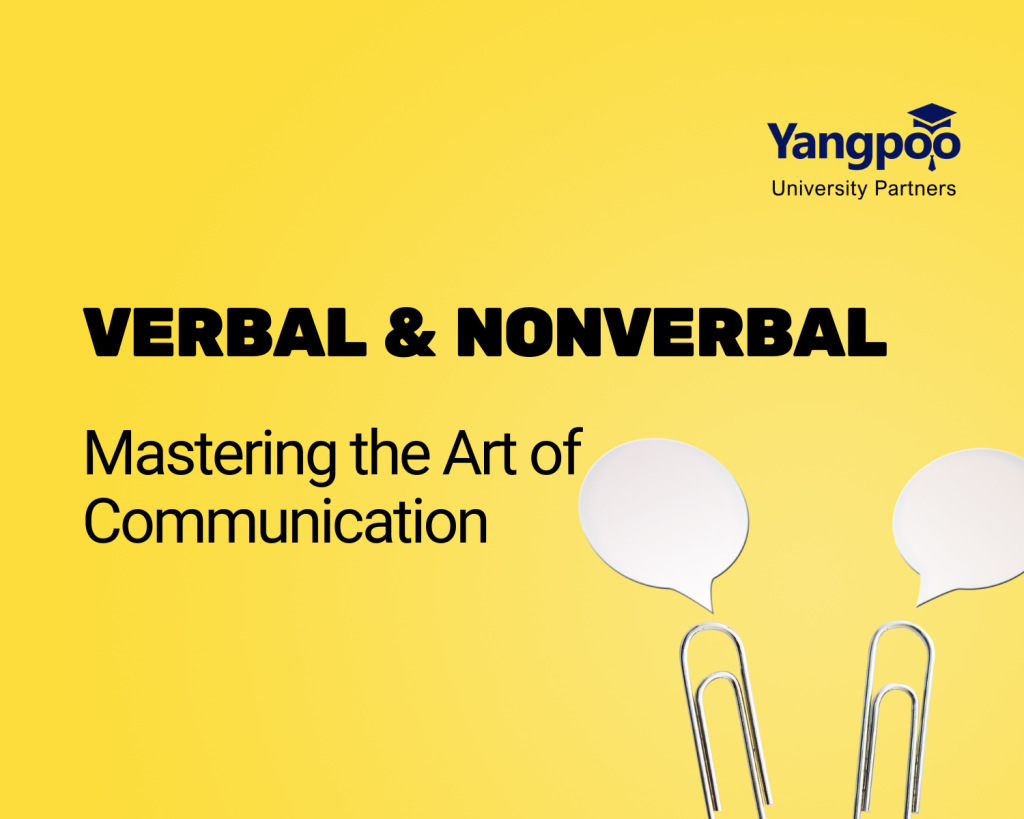In our interconnected world, effective verbal and non-verbal communication stands as a cornerstone of personal and professional success. Whether we’re engaging in a casual conversation with friends, delivering a critical presentation at work, or navigating professional relationships, our ability to convey ideas and emotions clearly can make or break our interactions. This blog delves into the intricate world of communication, exploring both verbal and non-verbal communication aspects, their benefits, and strategies for improvement.
What is Verbal Communication?
Verbal communication is the process of conveying messages through spoken or written words. It encompasses various forms, including face-to-face conversations, phone calls, emails, and public speaking. Effective verbal communication relies on clear word choice, appropriate tone, and context to ensure that the intended message is accurately conveyed and understood by the recipient.
Benefits of Verbal Communication?
Verbal communication takes various forms, each serving unique purposes:
- Face-to-Face Conversations: These direct interactions allow for immediate feedback and the richest form of communication.
- Phone Calls: Enabling real-time discussions over distances, phone calls bridge geographical gaps.
- Emails: Written communication that can be formal or informal, providing a record of exchanges.
- Public Speaking: Presentations or speeches delivered to audiences, often to inform or persuade.
Examples of Verbal Communication
Effective verbal communication offers several advantages:
- Clarity: It facilitates clear expression of thoughts and ideas.
- Efficiency: Information can be exchanged quickly and effectively.
- Relationship Building: Dialogue enhances interpersonal connections.
- Feedback: It enables immediate responses and clarifications.
Improve your Verbal Communication
Effective communication can take many forms, each offering unique advantages depending on the context and medium used. Whether through in-person interactions, audio-only calls, or virtual meetings, these communication methods provide individuals with various ways to connect, share information, and foster relationships. Below are three common types of communication that highlight the importance of immediacy, tone, and visual cues in different scenarios.
Face-to-Face Conversations:
- Direct, in-person interactions between two or more individuals.
- Allows for immediate feedback and interpretation of non-verbal cues.
phone calls:
- Real-time audio conversations conducted over telephone lines or internet connections.
- Crucial for long-distance communication, allowing for immediate response and tone interpretation.
Video Calls:
- Real-time audio and video conversations conducted over internet connections.
- Combines elements of face-to-face and phone conversations, important for remote work and long-distance relationships.
Improve your Verbal Communication
- Practice Active Listening: Pay attention to the speaker and respond thoughtfully.
- Be Clear and Concise: Use straightforward language to avoid misunderstandings.
- Seek Feedback: Encourage questions to clarify points and ensure understanding.
What is Non-Verbal Communication?
Though words hold great power, they are not the sole means of achieving effective communication. Non-verbal communication, the transmission of messages without words, plays a crucial role in how we interact with others. This form includes body language, facial expressions, gestures, posture, and tone of voice, often complementing verbal communication by adding emotional context and emphasis.
Benefits of Non-Verbal Communication
Non-verbal communication offers unique benefits, helping to convey emotions and reinforce verbal messages:
- Facial Expressions: Smiles, frowns, and other emotional indicators.
- Gestures: Hand movements that emphasize or convey messages.
- Posture: Body positioning suggesting confidence, openness, or discomfort.
- Eye Contact: Establishes connection and indicates engagement or disinterest.
Examples of Non-Verbal Communication.
Non-verbal communication offers unique benefits:
Facial Expressions: These are powerful indicators of emotion, such as smiling to show happiness or frowning to indicate sadness. Facial expressions can convey feelings more effectively than words alone.
Gestures: This includes deliberate movements like waving or pointing, as well as spontaneous actions like touching one’s face when nervous
Body Language (Kinesics): Body posture and movement communicate attitudes and emotions. For instance, standing straight may convey confidence, while slouching might suggest insecurity.
Give some pointers on improving Non-Verbal Communication.
To improve your non-verbal communication:
- Be Aware of Body Language: Monitor your gestures and expressions.
- Practice Empathy: Understand the non-verbal cues of others to enhance interaction.
- Maintain Appropriate Eye Contact: Foster engagement and trust during conversations.
Improve your Non-Verbal Communication
Although verbal and non-verbal communication is different concepts, they often work together to enhance understanding and convey meaning more effectively.. Consider how a simple phrase like “Good job” can take on entirely different meanings depending on the speaker’s tone, facial expression, and body language.
Difference between Verbal and Non-Verbal Communication
| Feature | Verbal Communication | Non-Verbal Communication |
|---|---|---|
| Definition | Use of spoken or written words | Transmission without words |
| Main Components | Words, tone | Gestures, body language |
| Benefits | Clarity, efficiency | Emotional expression, reinforcement |
| Examples | Conversations, emails | Facial expressions, eye contact |
| Improvement Strategies | Active listening, clarity | Awareness of body language |
Conclusion
Mastering both verbal and non-verbal communication is essential for effective communication is more than just speaking clearly or maintaining eye contact—it’s about harmonizing all aspects of your message. Here are some final tips to elevate your communication skills:
- Be Authentic: Ensure your verbal and non-verbal cues align with your message.
- Adapt to Your Audience: Tailor your communication style to the situation and the people involved.
- Practice Regularly: Like any skill, communication improves with consistent practice.
- Seek Feedback: Ask trusted friends or colleagues for honest feedback on your communication style.
- Stay Open-Minded: Be receptive to different communication styles and perspectives.
In conclusion, mastering both verbal and non-verbal communication is crucial for effective interaction in all areas of life. By understanding their unique characteristics and honing skills in each area, we can significantly enhance our personal and professional relationships, fostering better understanding and connection with others. Remember, becoming an excellent communicator is a lifelong journey embrace the process and keep refining your skills.
FAQ
What is Non-Verbal and Verbal Communication?
Ans. Verbal communication involves sharing information through spoken or written words, such as conversations, speeches, and emails. Non-verbal communication includes all forms of expression that do not use words, like facial expressions, gestures, and body language.
What is the Meaning of Verbal Communication?
Ans. Verbal communication is the process of conveying messages using spoken or written language. It relies on clarity and context to effectively express thoughts and feelings.
What is the Difference Between Verbal and Nonverbal Reasoning?
Ans. Verbal reasoning focuses on understanding concepts framed in words and is often assessed through language-based questions. In contrast, non-verbal reasoning evaluates problem-solving skills using visual patterns or shapes without relying on language.
What are the 4 Types of Communication?
Ans. The four types of communication are verbal communication (spoken or written words), non-verbal non-verbal communication (body language and gestures), visual (images and graphs), and written (reports and letters). Each type plays a unique role in conveying messages.
What are the Advantages of Verbal and Nonverbal Communication?
Ans. Verbal communication offers clarity and immediate feedback, allowing for the precise expression of ideas In contrast,. Non-verbal communication conveys emotions and reinforces verbal messages through body language and expressions.
What is the Importance of Non-Verbal Communication?
Ans. Non-verbal communication is crucial for expressing emotions and establishing rapport in interactions. It enhances the clarity of verbal communication by providing additional context through gestures, facial expressions, and tone.





